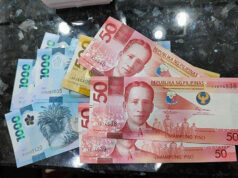Peso declines on inflation data
THE PESO weakened against the dollar to a fresh 12-year low on Wednesday following the faster-than-expected August inflation print.
The local currency ended Wednesday’s session at P53.55 versus the greenback, a centavo and a half weaker than the P53.535-per-dollar finish on Tuesday.
This was a fresh low for the peso in more than 12 years since it closed at P53.575 against the dollar on June 28, 2006.
The peso traded sideways the whole day, opening the session at P53.535 against the dollar. It slid to as low as P53.56, while its best showing for the day stood at P53.51 versus the greenback.
Dollars traded soared to $1.38 billion on Wednesday from the $440.75 million that exchanged hands the previous day.
A foreign exchange trader said the peso weakened as it continued to move within a very tight range.
“There’s a lot of trading today, but still the exchange rate continued to be pegged at around P53.55,” the trader said in a phone interview on Wednesday.
The trader added that the August inflation print “was a big surprise,” boosting investors’ speculation of another rate hike from the Bangko Sentral ng Pilipinas (BSP).
Inflation accelerated to a fresh nine-year high of 6.4% in August, the Philippine Statistics Authority reported on Wednesday, coming from July’s 5.7% and from 2.6% in August 2017.
The August print was beyond the upper end of the 5.5-6.2% estimate of BSP’s Department of Economic Research and was faster than the 5.9% median in a BusinessWorld poll of 14 economists.
“The market will probably expect another rate hike this month, although I’m not sure if it’s going to be 25 or 50 basis points,” the trader added.
In a statement, the central bank said it will be “looking more closely” at the latest data to reassess the medium-term inflation path.
“Given that the dollar-peso continues to be pressured to trade [weaker], I think the peso weakness in effect has to be controlled by the BSP to also control its effects on inflation,” the trader added.
Aside from faster August inflation, another trader attributed the peso’s weakness to the “broad safe-haven strengthening of the dollar ahead of the deadline of the US public consultation concerning additional tariffs on Chinese goods.”
Both traders noted that there was a huge intervention from the central bank at the P53.55 level given the large trading volume.
The BSP sometimes conducts “tactical interventions” to temper any sharp swings that may cause the peso to appreciate or depreciate.
For Thursday, the first trader expects the peso to move between P53.30 and P53.55 against the dollar, while the other gave a P53.45-P53.55 range. — Karl Angelo N. Vidal



